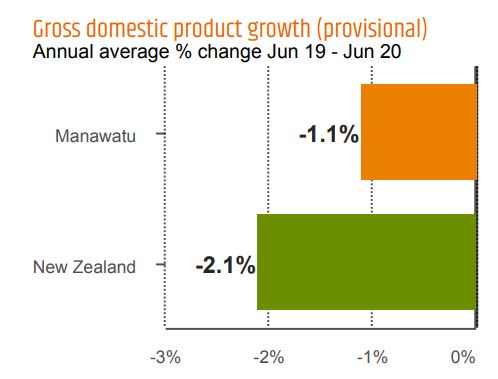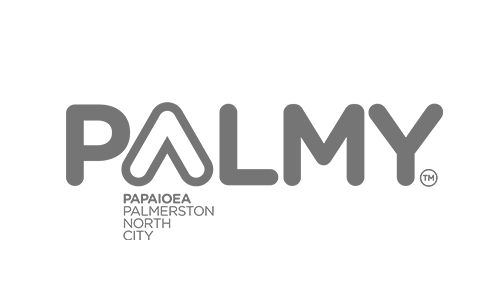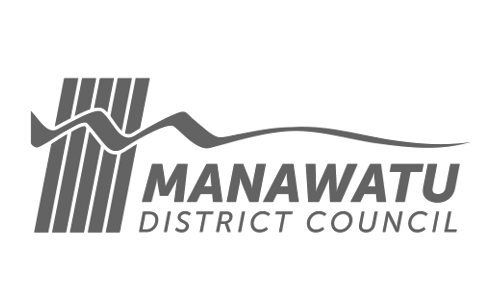Rate of Economic Growth – Palmerston North city and Manawatū district
“The Palmerston North city and Manawatū district economies are performing almost twice as well as the national economy, thanks to the region’s uniquely diversified economy and the sound economic development strategy that the region is following,” says Linda Stewart, CEO of the Central Economic Development Agency (CEDA). “Having a diverse economy means that our region is not reliant on one or two sectors. We have a significant public sector population, including education, defence and health, as well as strong logistics and manufacturing sectors, that ensures that we have a high level of employment and not as many of our population has lost their jobs during the pandemic. The employees working in these sectors still received their salaries during all Alert Levels and was not as much affected by COVID-19 as employees in other sectors,” says Stewart.
COVID-19
The June 2020 quarter will be noted in the history books for the largest single hit to the New Zealand economy, as the COVID-19 pandemic saw the country locked down at home for around four weeks at Alert Level 4, before a rapid move down the Alert Levels to Level 1 in early June.
The economy has undergone a remarkable shift in focus, from life support at Level 4 to an adrenaline rush at Level 1. Yet the immediate economic consequences are clear to see. Economic activity has fallen, Kiwis lost their jobs, businesses struggled to cope with lower earnings and incomes were reduced.
Economists are optimistic that recovery will happen, yet they are pessimistic about the recovery time and believe that the economic damage and restructuring will continue to occur over the next few years.
Manawatū Region
 It is important to note that regional economies are unique. Not all regions in New Zealand experienced the economic impacts of the COVID-19 pandemic equally. Regional economies with a strong international tourism focus were hit harder and will have a longer lasting effect, than regions such as Manawatū who aren’t as reliant on international visitation.
It is important to note that regional economies are unique. Not all regions in New Zealand experienced the economic impacts of the COVID-19 pandemic equally. Regional economies with a strong international tourism focus were hit harder and will have a longer lasting effect, than regions such as Manawatū who aren’t as reliant on international visitation.
Various economic indicators suggested that the Manawatū region is one of the regions who weathered the storm and will recover sooner with less prolonged effects to the region’s economy.
This does not mean that the region was not hit hard by the pandemic. The Manawatū Quarterly Economic Monitor (MQEM) indicated a 1.1% decline in the gross domestic product (GDP) in the region ended June 2020, due to the impact of COVID-19 Level-3 and 4 activity restrictions from 25 March to 13 May. Yet, the growth rate for GDP in the region is continuing well above the rate for the rest of New Zealand. Infometrics estimated an 8.5% decline in the June quarter for the Manawatū region, compared to the national 12.8% decline.
At the same time local leaders, businesses, and communities have shown incredible resilience to get their local economies moving again. Rapid deployment of support, and strong local coordination, has meant that regional economies have responded immediately with a focus on building the economy back together.
Primary Sector
Another reason why the region is performing well above average is that local economies with a strong primary sector, particularly in food production, have held up better as New Zealand’s exports continue to feed the world. This region is benefitting from continued strength in New Zealand’s food exports with meat and dairy export volumes both up on last year. The value of New Zealand exports is also favourable relative to the price of our imports, leading to record terms of trade for our exporters. Strong global demand for food produced in the region, in particular dairy products, and red meat, is expected to continue as the New Zealand reputation for quality continues to support demand.
Stephan Bell-Booth, CEO of Bell-Booth who primarily works with the New Zealand dairy industry says: “Dairy farmers were deemed providers of essential service during the first lockdown and have therefore pressed on with the business of running a dairy farm. While global prices for dairy are good, we have observed a dent in confidence and that has reflected in many farmers pressing pause on the purchase of capital items that would otherwise have been committed.”
“Further, the introduction of strictures around use of water and fertiliser beginning 1 July 2021 plus the introduction of a higher taxation regime, is a concern for farmers and could be the cause that a number of family-owned farms decide to sell up,” Bell-Booth explains.
Consumer Spending
 The resilience of the region is reflected in the strong increase in retail spending once New Zealand moved to Level 2 restrictions on 13 May. The growth rate for spending in the region is well above the growth rate for New Zealand with increased spending of 2.4% in the three months ended July 2020 compared to 0.4% for New Zealand over the same period.
The resilience of the region is reflected in the strong increase in retail spending once New Zealand moved to Level 2 restrictions on 13 May. The growth rate for spending in the region is well above the growth rate for New Zealand with increased spending of 2.4% in the three months ended July 2020 compared to 0.4% for New Zealand over the same period.
“However, this rebound hasn’t been enough to make up for what wasn’t spent, with Marketview data showing spending in the June 2020 quarter was down 19.7% compared to the same quarter last year,” says Manawatū District Economist Stacey Bell.
Considering the status of Palmerston North as a regional retail hub and the impacts of the Level 3 and Level 4 lockdown that fell predominantly in the June quarter, this hit to retail spending is not surprising. Quarterly data to the end of July indicates a turn around with consumer spending in the region rising by 1.6% compared with the July quarter 2019. This compares favourably with national data, where retail spending in the July quarter increased by just 0.3%.
The Choose Manawatū initiative launched by Manawatu Chamber of Commerce, Feilding and District Promotion, Palmy BID, Manawatu District Council and Palmerston North City Council, to drive local consumers to spend, shop and support local is bearing fruit with Marketview data indicating that Manawatū locals do more spending locally than the rest of New Zealand.
“We know that buying local has a multiplier effect on our local economy, and now it is more important than ever to think consciously about our purchasing decisions.” says Stewart.
Insights for businesses in the region
Recovery from COVID-19 will take time. “Businesses in the Manawatū should make use of the opportunities that arise with the change of consumer behaviour, says Stewart. “Online spending in the region increased remarkably by 16% in the last three months, while national growth was 3.8%. Digital enablement is low hanging fruit and companies should adapt to having an online presence and trading online.”
Digital capability is one of the areas specifically supported by the NZTE Regional Business Partner programme that CEDA delivers in the region, along with other forms of support, advice, and mentoring.
National data indicates that regions with a strong Regional Business Partners programme are proving more resilient as businesses ride out the COVID-19 economic shock.
“I would encourage any business who is struggling through this period of uncertainty, to get in touch with our team of Business Growth Advisors and access the necessary support,” Stewart adds.
Housing and Labour Market dynamics
 House values have grown strongly in the year to June 2020. The average current house value in the Manawatū was up 16.9 % compared with June 2019. Growth here outperformed relative to New Zealand, where prices increased by 7.5%. The average current house value was $482,658 over the June 2020 year, compared with $724,155 in New Zealand.
House values have grown strongly in the year to June 2020. The average current house value in the Manawatū was up 16.9 % compared with June 2019. Growth here outperformed relative to New Zealand, where prices increased by 7.5%. The average current house value was $482,658 over the June 2020 year, compared with $724,155 in New Zealand.
A total of 1,799 houses were sold in Manawatū in the 12 months ended June 2020. House sale volumes fell sharply in the June quarter with a decrease of 10.8% compared to the previous year. This is attributed to the lockdown during the June 2020 quarter constraining the number of days that properties could be traded.
The property market in New Zealand is currently feeling the pressure of increased demand for houses versus the low rate of supply hence the total number of homes available for sale and the low stock around the country is driving the house prices higher. New Zealand’s housing shortage remains an issue and that it is likely to be intensified by Kiwis returning home from overseas.
“It is good news for both homeowners and sellers if the market is performing well. On the flipside, it makes it extremely difficult to enter the property market for first-time buyers,” explains Stewart.
The current housing market constraints also have a major influence on our ability as a region to attract talent to the region. “One of the challenges that the region is faced with is that there is currently a short supply and high demand for housing – both for renting and purchasing. Additionally, the type of housing available is not always suitable for those considering relocating to the Manawatū region. Those considering relocating may be drawn to the affordability aspect of housing in the region, however, they could be put off relocating as they might not be able to find a suitable home due to housing stock shortages,” says Sara Towers, Talent and Skills Manager at CEDA, who recently relocated to the region and experienced this first hand.
“The competition is driving house prices up and while it is still affordable compared to other cities such as Auckland or Wellington, people buying are having to secure the home by offering a lot more than the asking price and homes are getting multi-offers in on them.” Towers concludes.
 A total of 251 new residential building consents were issued in Manawatū this quarter. On an annual basis the number of consents for the region increased by 21.9% compared with the same 12-month period last year. Housing consents, is good news for the region, but are we as a region quick enough at building? Peter Crawford, Economic Policy Advisor for the Palmerston North City Council says: “Recent District Plan changes are encouraging more higher density housing to be built in the city, allowing land to be used more efficiently. It is also progressing on plans to rezone more land for residential development in multiple sites in and around the city. Demand for housing in the past four years has increased significantly more than was forecast.
A total of 251 new residential building consents were issued in Manawatū this quarter. On an annual basis the number of consents for the region increased by 21.9% compared with the same 12-month period last year. Housing consents, is good news for the region, but are we as a region quick enough at building? Peter Crawford, Economic Policy Advisor for the Palmerston North City Council says: “Recent District Plan changes are encouraging more higher density housing to be built in the city, allowing land to be used more efficiently. It is also progressing on plans to rezone more land for residential development in multiple sites in and around the city. Demand for housing in the past four years has increased significantly more than was forecast.
Business Outlook
Vicki Stewart, owner of Palmerston North’s Mitre 10 Mega retail store says: “We are feeling more positive about the future as the outlook for the Manawatū is not as grim as predicted. Manawatū has a diverse economy that protects us from large down turns, a business community that has come together to support each other, a strong community, and agencies such as CEDA giving access to information and support. While there is still a head wind to come, we are a region that will continue to bat above its weight.”
Please find the full reports, below.
For more information:
Janet Reynolds
Marketing and Communications Manager
[email protected]






